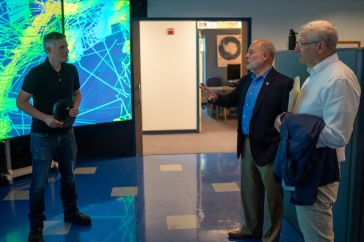
Meagan Wengrove ('18G) has shaped a career out of sand and sediment movement.
If you’ve ever taken a stroll along the sandy portions of the Seacoast, you’ll know just how dynamic coastal systems can be — the sand is constantly moving around, scoured out in some places and pushed back up in others, making it an outdoor laboratory for studying sand and sediment transport. Meagan Wengrove '10 '18G is making a career out of this topic, taking what she’s learned in New Hampshire and heading off to the West Coast for the next step in her life.
This fall, Wengrove will start as an assistant professor of civil engineering with a focus on coastal engineering at Oregon State University in Corvallis. She’s diving right into her teaching and research duties, the latter of which will focus on both the evolution of and feedback between small to medium-scale coastal morphology and the use of engineered nature-based coastal buffers, such as marshes and dunes, as coastal protection strategies. It’s a whole new coast for her to learn about, but Wengrove is confident that the skills and knowledge base she picked up here at UNH will help her settle in just fine.

From her early undergraduate days at UNH, Wengrove was excited to pair civil engineering with fluid dynamics — she’s got a fascination with water that drives much of her scientific inquiry. She worked with Diane Foster, UNH associate professor of mechanical engineering, for her Master of Science to learn about nutrient diffusion through sediments in Great Bay. After spending a year in the Netherlands on a Fulbright Scholarship, Wengrove returned to UNH to work on her Ph.D. research that focused on the impact of sand ripples on large-scale sand movement and transport.
Along the way, Wengrove’s student career evolved at the same time the UNH School of Marine Science and Ocean Engineering (SMSOE) grew into its current interdisciplinary form. From the school’s Graduate Research Conference to new lab spaces and research vessels, the SMSOE now offers plentiful opportunities for undergrads, graduate students and faculty who want to dig in and enhance their experience — and improve their resumes along the way.
“The Marine School has grown a lot in recent years, and it’s cool to see everyone working together more closely,” Wengrove says. “It’s a more cohesive unit now, and that makes UNH stronger, too. There are so many people working on different projects on the water and it’s really easy to collaborate with them and to share resources,” she adds.
Wengrove wants to encourage students who are interested in engineering to consider researching ocean-related topics at UNH and to jump in and explore what the UNH Marine School has to offer.
“The UNH Marine School has new lab spaces, research boats, indoor tow- and test- tanks, and accessible and excited faculty and students. Plus the Great Bay and the Atlantic Ocean are in our back yard — there’s a lot right here,” she says.
See where a career in ocean engineering can take you.
-
Written By:
Rebecca Irelan | Institute for the Study of Earth, Oceans, and Space | rebecca.irelan@unh.edu | 603-862-0990



















































